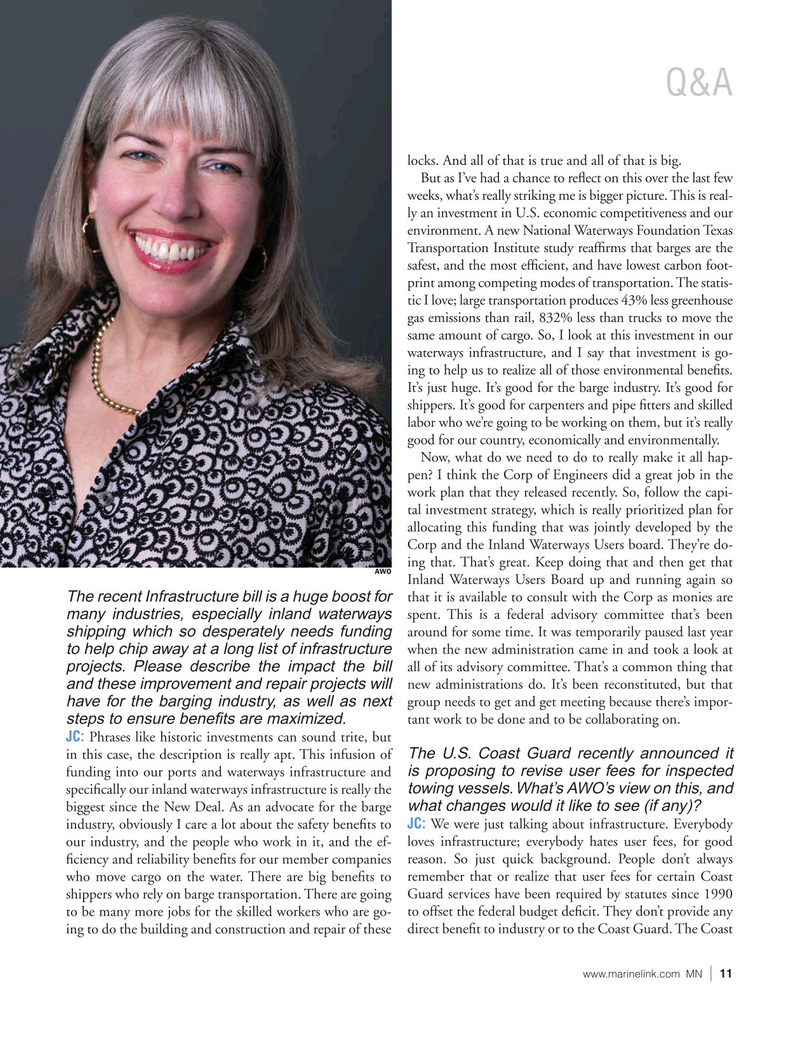
Page 11: of Marine News Magazine (March 2022)
Pushboats, Tugs & Barges
Read this page in Pdf, Flash or Html5 edition of March 2022 Marine News Magazine
Q&A locks. And all of that is true and all of that is big.
But as I’ve had a chance to re? ect on this over the last few weeks, what’s really striking me is bigger picture. This is real- ly an investment in U.S. economic competitiveness and our environment. A new National Waterways Foundation Texas
Transportation Institute study reaf? rms that barges are the safest, and the most ef? cient, and have lowest carbon foot- print among competing modes of transportation. The statis- tic I love; large transportation produces 43% less greenhouse gas emissions than rail, 832% less than trucks to move the same amount of cargo. So, I look at this investment in our waterways infrastructure, and I say that investment is go- ing to help us to realize all of those environmental bene? ts.
It’s just huge. It’s good for the barge industry. It’s good for shippers. It’s good for carpenters and pipe ? tters and skilled labor who we’re going to be working on them, but it’s really good for our country, economically and environmentally.
Now, what do we need to do to really make it all hap- pen? I think the Corp of Engineers did a great job in the work plan that they released recently. So, follow the capi- tal investment strategy, which is really prioritized plan for allocating this funding that was jointly developed by the
Corp and the Inland Waterways Users board. They’re do- ing that. That’s great. Keep doing that and then get that
AWO
Inland Waterways Users Board up and running again so that it is available to consult with the Corp as monies are
The recent Infrastructure bill is a huge boost for spent. This is a federal advisory committee that’s been many industries, especially inland waterways around for some time. It was temporarily paused last year shipping which so desperately needs funding when the new administration came in and took a look at to help chip away at a long list of infrastructure all of its advisory committee. That’s a common thing that projects. Please describe the impact the bill new administrations do. It’s been reconstituted, but that and these improvement and repair projects will group needs to get and get meeting because there’s impor- have for the barging industry, as well as next tant work to be done and to be collaborating on.
steps to ensure bene? ts are maximized.
JC: Phrases like historic investments can sound trite, but
The U.S. Coast Guard recently announced it in this case, the description is really apt. This infusion of is proposing to revise user fees for inspected funding into our ports and waterways infrastructure and towing vessels. What’s AWO’s view on this, and speci? cally our inland waterways infrastructure is really the what changes would it like to see (if any)?
biggest since the New Deal. As an advocate for the barge industry, obviously I care a lot about the safety bene? ts to JC: We were just talking about infrastructure. Everybody our industry, and the people who work in it, and the ef- loves infrastructure; everybody hates user fees, for good ? ciency and reliability bene? ts for our member companies reason. So just quick background. People don’t always who move cargo on the water. There are big bene? ts to remember that or realize that user fees for certain Coast shippers who rely on barge transportation. There are going Guard services have been required by statutes since 1990 to be many more jobs for the skilled workers who are go- to offset the federal budget de? cit. They don’t provide any ing to do the building and construction and repair of these direct bene? t to industry or to the Coast Guard. The Coast www.marinelink.com MN 11|

 10
10

 12
12
